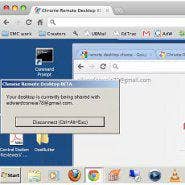Build Your Own Remote Desktop Tool For Free

The Chrome developer community Friday released the first beta of Chrome Remote Desktop, a Chrome extension that allows any machine running Google's open-source browser to connect to and control any other machine running Chrome, be it on Linux, Mac OS X or Windows.
For solution providers, the tool turns Chrome into a platform for building a remote support utility for client endpoints that's 100 percent free. The software even works with Chromebooks, although only as a guest for now; Chromebooks cannot yet act as hosts to be be remotely controlled.
Like most browser plug-ins, Chrome Remote Desktop is simple to install. For machines already running Chrome, simply point the browser to the Chrome Remote Desktop web page or search for it in the Chrome Web Store to download and install the extension.
Once installed, an icon appears on new Chrome Home Page windows or tabs that when clicked prompts the user to "Share this Computer" and "Access a Shared Computer." Opting to share generates a 12-number code that the remote user enters into the Chrome Remote Desktop-enabled browser on their end (after opting to access a shared computer).
The remote desktop of the shared computer appears in the browser window, like a bare-bones version of GoToMyPC from Citrix, but without the monthly charge. A tab at the top of the browser window drops down when the mouse hovers near, displaying the name of the person controlling your machine along with controls for scaling and ending the session. When scaling is selected, the remote screen automatically shrinks or stretches to fit the browser window whenever it's resized.
There are lots of reasons to be excited about Chrome Remote Desktop, not the least of which is that it's free and built on an open-source browser that is actually quite good. Also, it installs easily (as does the browser itself) and is compatible with all major desktop operating systems and Chromebooks. We tested it on a Samsung Series 5 Chromebook (we had to update to Chrome 14 on Chrome OS 811.117) as well as Mac OS X and Windows 7. The version we tested was Chrome Remote Desktop 1.2.20109.8300.
Once connected, either party can disconnect using an always-on-top dialog box dedicated to the task. Security is never in question as a unique code is generated by the host for each sharing session, and it only works with one guest. Curious if the tool would allow two guests to connect to a single host at once, we generated a code and used it to connect to one guest, then attempted to connect a second guest using the same access code. This crashed the extension and that sharing session was lost.
We tested the extension on all three of its four supported platforms, connecting multiple windows and tabs from Chromebook to Mac OS and Windows and between Windows and Mac OS. When sharing, the host machine can be seen and controlled by the guest and the host at the same time. Performance was adequate, stable and predictable. Response time was better in native resolution than when using screen scaling.
The tool is not for every job, however. This is not a replacement for an RDP client such as Cybele Software's ThinRDP, and it cannot connect to "headless" systems such those in a data center; someone has to be present at the remote host to initiate a sharing session and generate an access code. After about 15 minutes, an inactive session will time out, and a new code will be required to resume it. Developers are working on a version suitable for accessing one's own machine from elsewhere.
Still, the Chrome Remote Desktop beta represents an excellent first pass at making remote control a free and available to everyone running the Chrome browser. This product could have a lasting effect on the remote control business as it gives solution providers a no-cost platform for support-desk tools development.